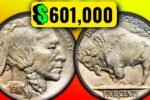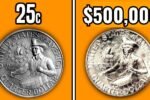The Lincoln Wheat Penny is a beloved piece of American coinage history. First introduced in 1909 to mark the 100th anniversary of Abraham Lincoln’s birth, it was groundbreaking for featuring a real historical figure—President Lincoln—instead of symbolic designs like Lady Liberty. The reverse side, adorned with two wheat stalks, gave the coin its nickname, the “Wheat Penny.” These coins remained in production until 1958 when the design was updated to the Lincoln Memorial.
While most Wheat Pennies are worth only a cent, certain rare editions have captured the attention of collectors and can fetch staggering sums at auctions. One such penny, reportedly valued at $960,000, has sparked excitement among numismatists and casual coin hunters alike. But what makes a simple penny worth nearly a million dollars?
What Makes a Lincoln Wheat Penny So Valuable?
Not every old penny is a hidden treasure. Several key factors determine whether a Lincoln Wheat Penny is worth a fortune:
- Minting Errors: Mistakes during production, such as double strikes, off-center designs, or incorrect metal compositions, can turn an ordinary penny into a rare collectible. For example, the famous 1955 Double Die Obverse penny, where the date and inscriptions appear doubled, is highly sought after.
- Low Mintage: Some years saw very few pennies produced, making surviving specimens extremely rare. The 1914-D Wheat Penny, struck at the Denver Mint, had a limited mintage, and well-preserved examples can sell for thousands.
- Exceptional Condition: Coins that have never been circulated or remain in pristine condition (graded as “Mint State” by professional graders) command much higher prices than worn or damaged ones.
- Unique Features: Certain pennies stand out due to unusual characteristics, such as missing mint marks or unexpected materials. The most famous example is the 1943 Copper Penny, accidentally struck in copper instead of steel during World War II. Only a handful exist, making them worth hundreds of thousands—or even millions—of dollars.
Key Lincoln Wheat Pennies to Look For
If you’re searching through old coins, here are some of the most valuable editions to keep an eye out for:
- 1909-S VDB – Features the designer’s initials (VDB) on the reverse. Worth $1,000 to $10,000+ depending on condition.
- 1914-D – Low mintage from the Denver Mint. Valued at $2,000 to $20,000 in higher grades.
- 1922 No D – Missing the “D” mint mark due to an error. Can fetch $5,000 to $30,000+.
- 1943 Copper – A rare mistake from WWII. Authentic examples can sell for up to $960,000 or more.
- 1955 Double Die Obverse – A striking error that makes the date appear doubled. Worth $1,500 to $10,000+.
How to Identify a Rare Wheat Penny
Before you start sifting through your coin jar, here’s what to check:
1. Check the Year
Focus on pennies minted before 1959, especially 1909, 1914, 1922, 1943, and 1955, as these are key dates with valuable variants.
2. Look for Mint Marks
A small letter under the date indicates where the coin was minted:
- “D” – Denver Mint
- “S” – San Francisco Mint
- No mint mark – Philadelphia Mint
3. Inspect for Errors
Use a magnifying glass to check for double strikes, off-center designs, or missing details. The 1955 Double Die is a prime example of a valuable error.
4. Weight and Magnet Test (For 1943 Pennies)
- A 1943 steel penny weighs about 2.7 grams and is magnetic.
- A 1943 copper penny weighs 3.11 grams and is not magnetic—this is the rare version worth a fortune.
Could a Rare Wheat Penny Still Be in Circulation?
Believe it or not, yes! While most high-value pennies have been found by collectors, some rarities still slip through the cracks. They might turn up in:
- Old coin rolls from banks
- Antique collections or inherited jars of coins
- Everyday change (though this is extremely rare)
The thrill of possibly finding a hidden treasure keeps many collectors and casual searchers on the lookout.
What to Do If You Find a Rare Wheat Penny
If you think you’ve stumbled upon a valuable penny, follow these steps:
- Do Not Clean It – Cleaning can damage the coin and reduce its value.
- Get It Appraised – Consult a professional coin grader or reputable dealer.
- Research Comparable Sales – Check auction sites like Heritage Auctions or eBay for similar coins.
- Preserve It Properly – Store it in a protective sleeve or case to prevent wear.
Frequently Asked Questions
Q: Why is the 1943 copper penny so valuable?
A: During WWII, pennies were supposed to be made of steel to conserve copper for the war effort. A few copper blanks were accidentally used, making these pennies extremely rare.
Q: Can I find valuable pennies in my pocket change?
A: While unlikely, it’s not impossible—always check your coins!
Q: Are all Wheat Pennies worth more than a cent?
A: Most are only worth face value, but certain years, errors, or conditions can make them highly valuable.
Q: Where can I sell a rare penny?
A: Options include coin dealers, auctions, or online marketplaces—but always get it authenticated first.
Final Thoughts
The Lincoln Wheat Penny is more than just spare change—it’s a piece of history and, for a lucky few, a life-changing discovery. Whether you’re a seasoned collector or just curious, taking a closer look at your pennies could reveal a hidden gem. Who knows? The next $960,000 rarity might be hiding in your pocket!




